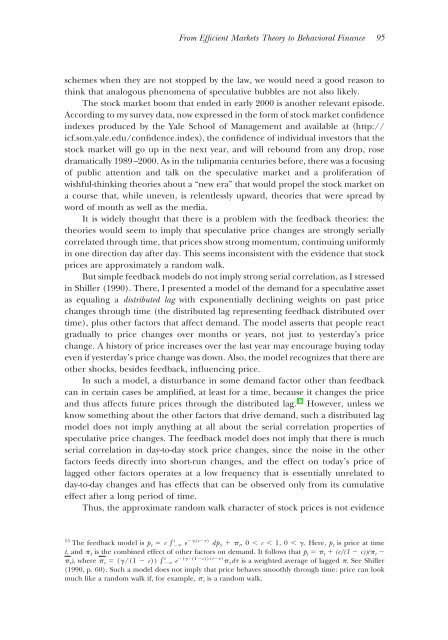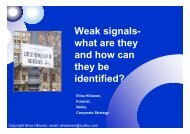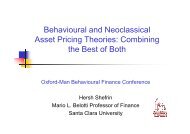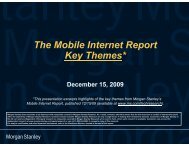From Efficient Markets Theory to Behavioral Finance
From Efficient Markets Theory to Behavioral Finance
From Efficient Markets Theory to Behavioral Finance
You also want an ePaper? Increase the reach of your titles
YUMPU automatically turns print PDFs into web optimized ePapers that Google loves.
<strong>From</strong> <strong>Efficient</strong> <strong>Markets</strong> <strong>Theory</strong> <strong>to</strong> <strong>Behavioral</strong> <strong>Finance</strong> 95<br />
schemes when they are not s<strong>to</strong>pped by the law, we would need a good reason <strong>to</strong><br />
think that analogous phenomena of speculative bubbles are not also likely.<br />
The s<strong>to</strong>ck market boom that ended in early 2000 is another relevant episode.<br />
According <strong>to</strong> my survey data, now expressed in the form of s<strong>to</strong>ck market confidence<br />
indexes produced by the Yale School of Management and available at http://<br />
icf.som.yale.edu/confidence.index, the confidence of individual inves<strong>to</strong>rs that the<br />
s<strong>to</strong>ck market will go up in the next year, and will rebound from any drop, rose<br />
dramatically 1989–2000. As in the tulipmania centuries before, there was a focusing<br />
of public attention and talk on the speculative market and a proliferation of<br />
wishful-thinking theories about a “new era” that would propel the s<strong>to</strong>ck market on<br />
a course that, while uneven, is relentlessly upward, theories that were spread by<br />
word of mouth as well as the media.<br />
It is widely thought that there is a problem with the feedback theories: the<br />
theories would seem <strong>to</strong> imply that speculative price changes are strongly serially<br />
correlated through time, that prices show strong momentum, continuing uniformly<br />
in one direction day after day. This seems inconsistent with the evidence that s<strong>to</strong>ck<br />
prices are approximately a random walk.<br />
But simple feedback models do not imply strong serial correlation, as I stressed<br />
in Shiller (1990). There, I presented a model of the demand for a speculative asset<br />
as equaling a distributed lag with exponentially declining weights on past price<br />
changes through time (the distributed lag representing feedback distributed over<br />
time), plus other fac<strong>to</strong>rs that affect demand. The model asserts that people react<br />
gradually <strong>to</strong> price changes over months or years, not just <strong>to</strong> yesterday’s price<br />
change. A his<strong>to</strong>ry of price increases over the last year may encourage buying <strong>to</strong>day<br />
even if yesterday’s price change was down. Also, the model recognizes that there are<br />
other shocks, besides feedback, influencing price.<br />
In such a model, a disturbance in some demand fac<strong>to</strong>r other than feedback<br />
can in certain cases be amplified, at least for a time, because it changes the price<br />
and thus affects future prices through the distributed lag. 15 However, unless we<br />
know something about the other fac<strong>to</strong>rs that drive demand, such a distributed lag<br />
model does not imply anything at all about the serial correlation properties of<br />
speculative price changes. The feedback model does not imply that there is much<br />
serial correlation in day-<strong>to</strong>-day s<strong>to</strong>ck price changes, since the noise in the other<br />
fac<strong>to</strong>rs feeds directly in<strong>to</strong> short-run changes, and the effect on <strong>to</strong>day’s price of<br />
lagged other fac<strong>to</strong>rs operates at a low frequency that is essentially unrelated <strong>to</strong><br />
day-<strong>to</strong>-day changes and has effects that can be observed only from its cumulative<br />
effect after a long period of time.<br />
Thus, the approximate random walk character of s<strong>to</strong>ck prices is not evidence<br />
15 t<br />
The feedback model is p t c e (t) dp t ,0 c 1, 0 . Here, p t is price at time<br />
t, and t is the combined effect of other fac<strong>to</strong>rs on demand. It follows that p t t (c/(1 c))( t <br />
t<br />
t ), where t (/(1 c)) e (/(1c))(t) d is a weighted average of lagged . See Shiller<br />
(1990, p. 60). Such a model does not imply that price behaves smoothly through time: price can look<br />
much like a random walk if, for example, t is a random walk.
















